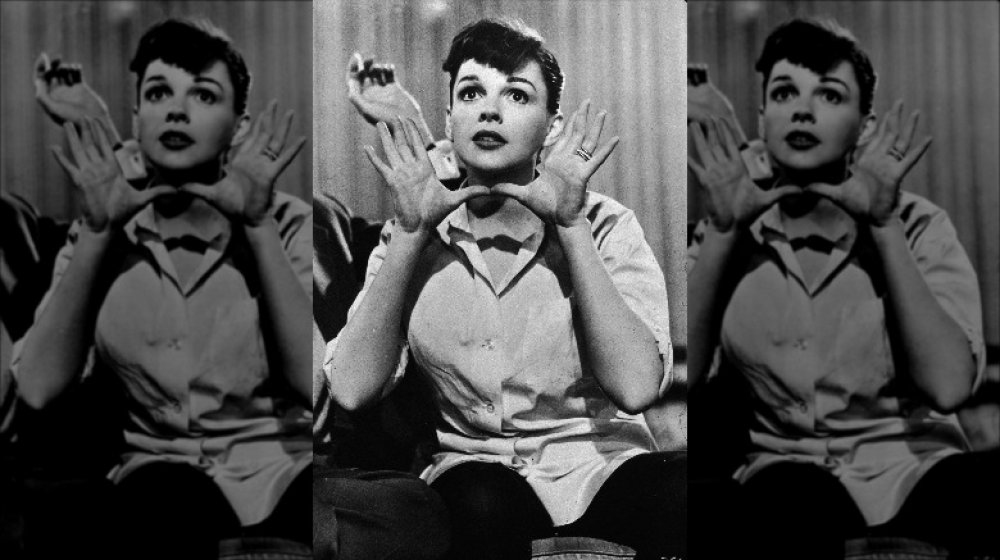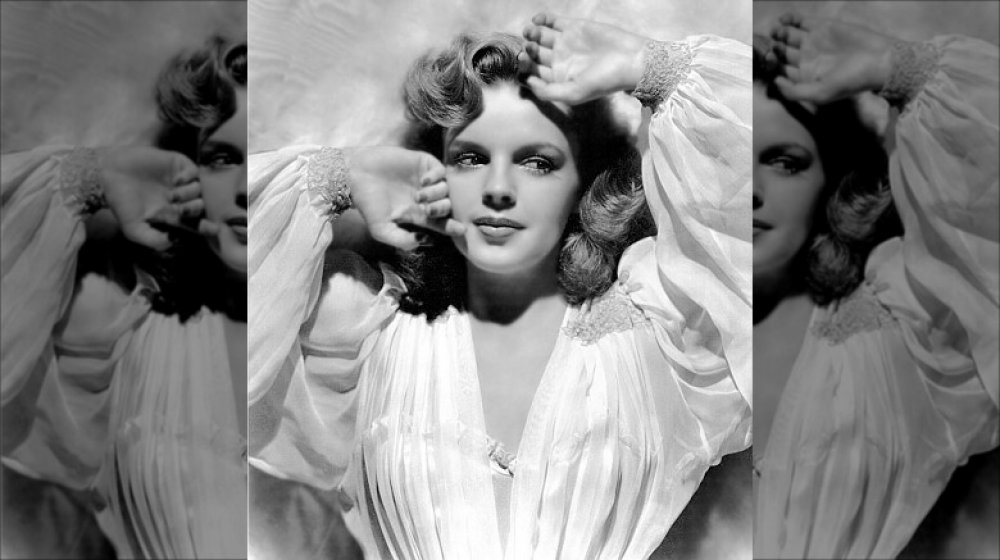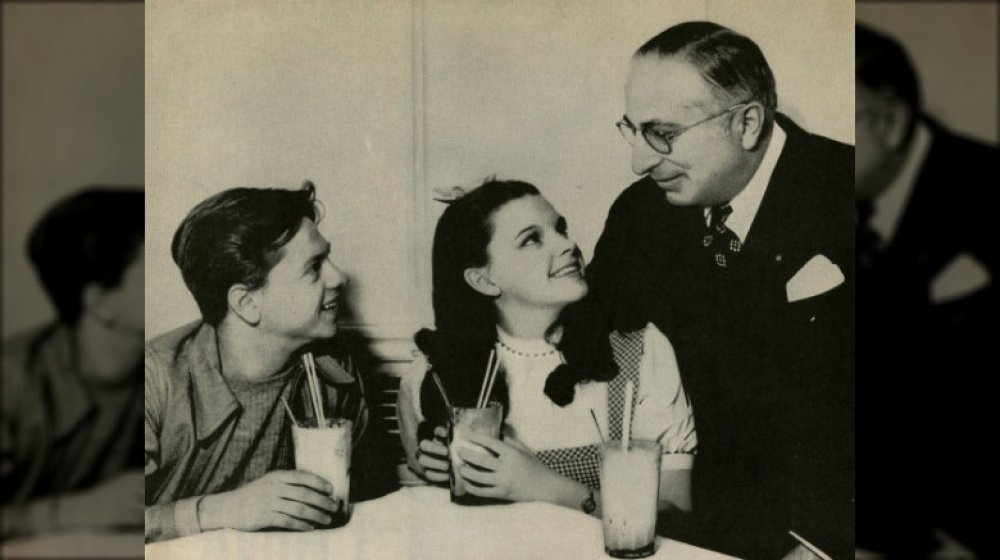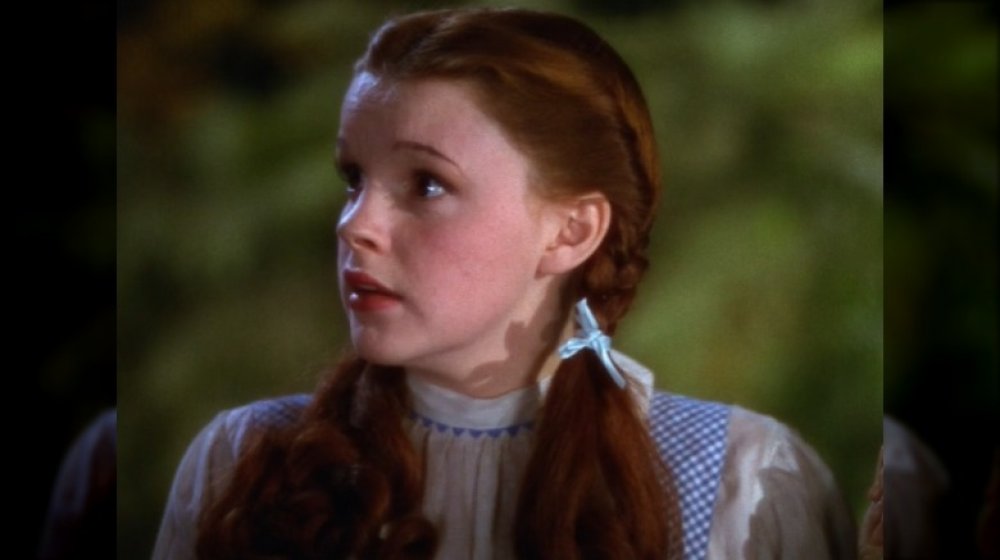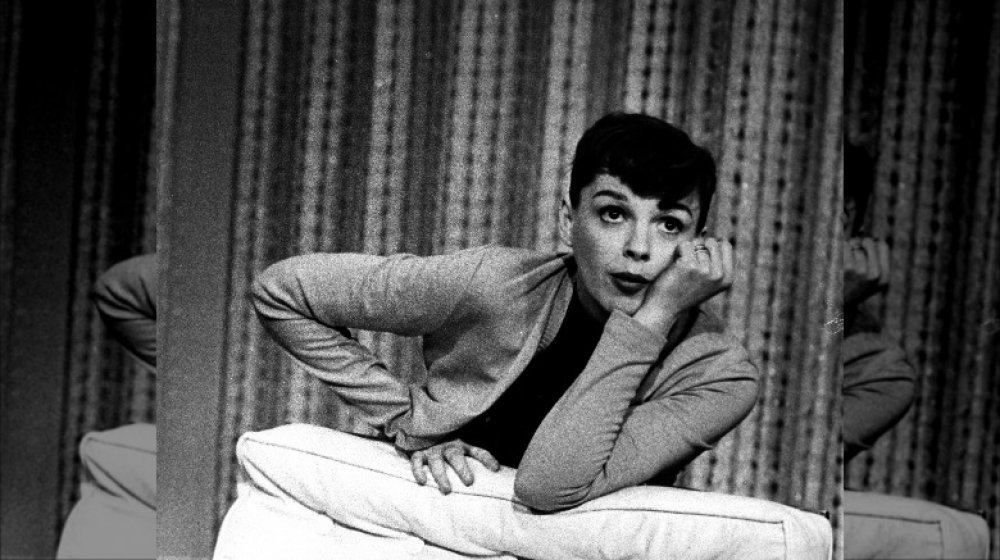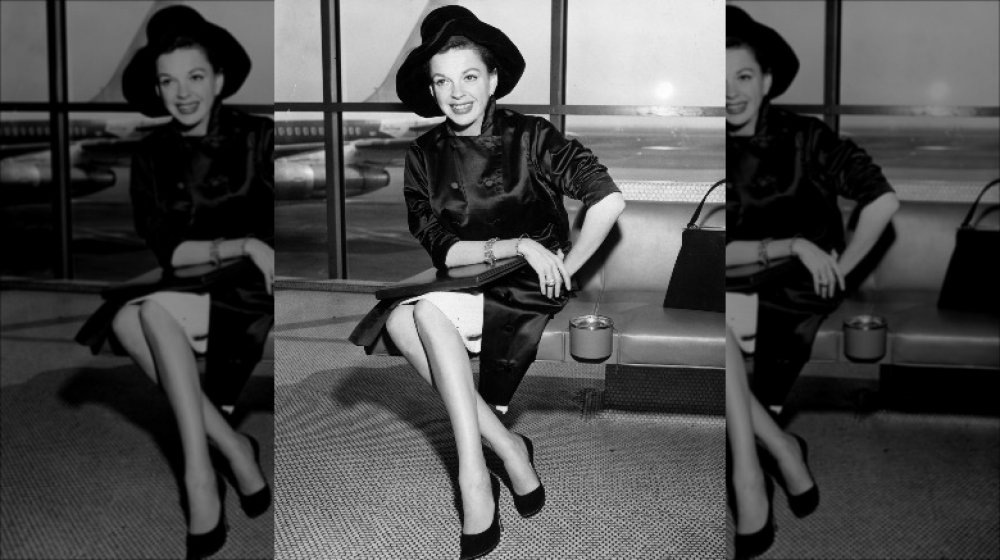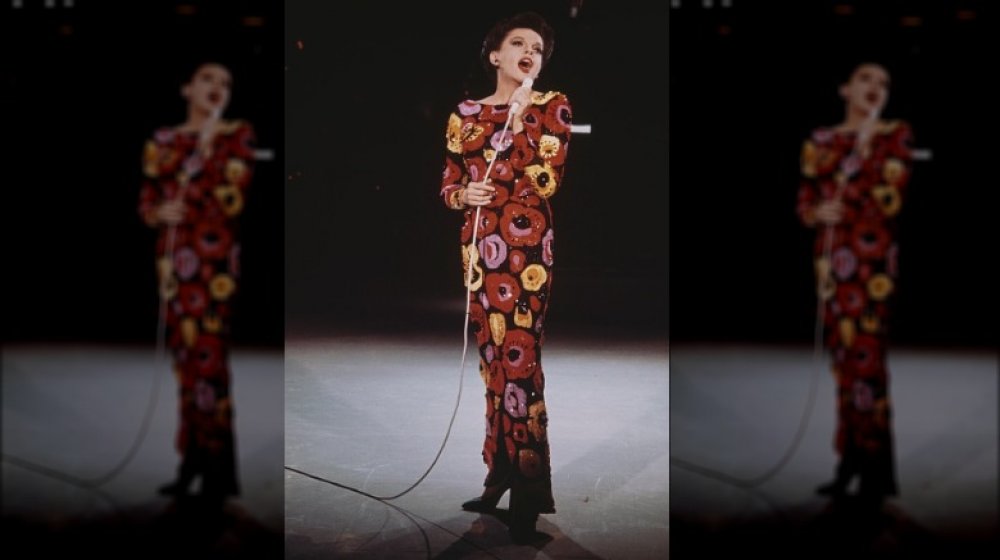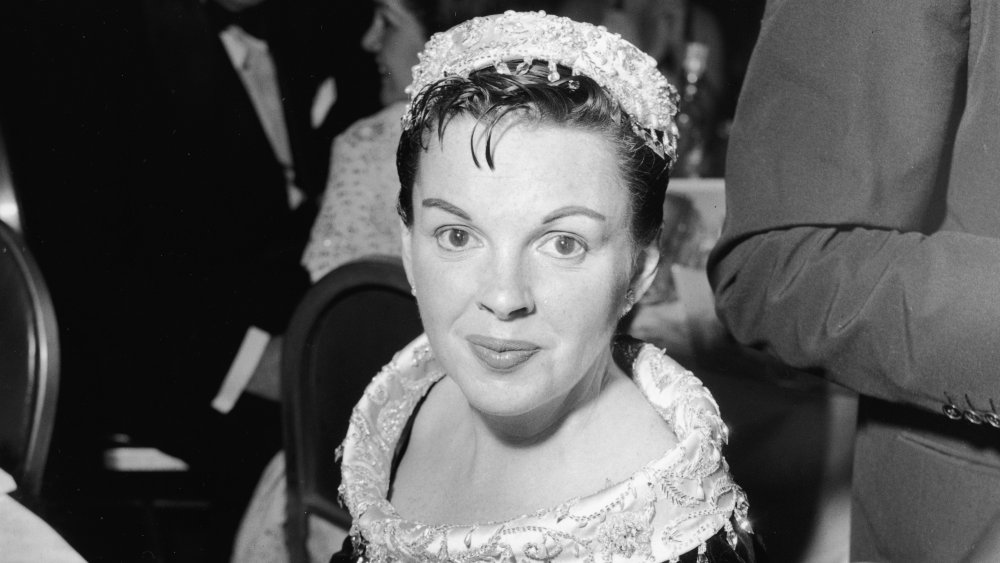The Untold Truth Of Judy Garland's Mysterious Death
We may receive a commission on purchases made from links.
Some met Judy Garland the first time they watched The Wizard of Oz or Meet Me in St. Louis. Others first came to know her through Reneé Zellwegger's Oscar-winning turn in the 2019 biopic Judy. Regardless, it's fair to say that Garland's legacy is one of the most enduring and tragic in Hollywood history. As a woman who spoke openly about her battles with addiction and mental health at a time when both were highly stigmatized — even more so than today — Garland endured public ridicule and scorn from the very industry that made her a household name.
Despite Hollywood's rejection in the final years of her life, her death from an accidental overdose at age 47 still managed to shock and sadden her loyal fanbase. The fact that it occurred as Garland seemed to be making a much-lauded comeback, selling out shows in New York City's Madison Square Garden and Palace Theatre, as well as a five-week run at London's Talk of the Town nightclub (the subject of the aforementioned biopic) in the year leading up to her death only further underscored and heightened the sense of tragedy felt around the world. Read on to find out the untold truth of Judy Garland's mysterious death.
Judy Garland followed in her family's footsteps
While the phrase "Judy Garland" might invoke images of a girl in gingham stepping into a Technicolor dreamscape for the very first time, or a world-worn woman, alone but triumphant, on the stage of Carnegie Hall, the woman-who-would-be-Judy spent her earliest years under a different name entirely. Born Frances Ethel Gumm on June 10, 1922, in Grand Rapids, Minn., Garland's foray into show business was predestined from the start. As detailed in Gerald Clarke's 2009 tome Get Happy: The Life of Judy Garland — largely considered the definitive biography on the actress — Garland's parents, both vaudeville circuit veterans, put the young Frances to work on the stage at the tender age of two.
Alongside her two older sisters and parents, Garland began to tour around the country. Initially billed as "The Gumm Sisters," their parents eventually changed it to "The Garland Sisters" after the girls were purportedly told to come up with a moniker with more audience appeal. According to Garland's daughter Lorna Luft, whose 1998 work Me and My Shadows: A Family Memoir served as the basis for the 2001 award-winning television miniseries of the same name, the decision to adopt the nom de theatre was inspired in particular by producer George Jessel, who fondly stated that the sisters "looked prettier than a garland of flowers." From 1934 onwards, Frances would be known to the world by one name only: Judy Garland.
Judy Garland's childhood at MGM set her up for later battles
At the age of 13, Judy Garland found herself at the next stage of career when she signed on as a contract starlet for Metro-Goldwyn-Mayer, one of the major powerhouse movie studios of its day. Thanks to firsthand accounts included in works ranging from Gerald Clarke's Get Happy to historian Karina Longworth's You Must Remember This podcast, MGM's mistreatment of their child actors is now well-known and, unfortunately, the teenage Judy purportedly suffered some of the worst of it.
According to multiple sources, Garland was consistently berated for her short stature of 4'11", nicknamed the "little hunchback" by temperamental studio head Louis B. Mayer, and was fed a steady diet of amphetamines and barbiturates in order to keep her to working long hours at the studio. During her time at MGM, Garland's body was constantly under scrutiny, with the studio going as far as to put caps on her teeth and rubber discs inside her nose to alter its shape. As depicted in the Garland biopic Judy, her diet was also heavily restricted by the studio — MGM reinforced a strict regimen of chicken broth and plain lettuce, even if Garland asked for otherwise. Garland ultimately credited this treatment as the foundation for her problems later in life, including a recurrent eating disorder and her long battle with substance abuse.
As Dorothy, Judy Garland saw the dark side of Oz
Judy Garland's breakout role as Dorothy Gale in the 1939 classic The Wizard of Oz might still be the one she's best known for, despite her myriad iconic performances in films like Meet Me in St. Louis, A Star Is Born, and Easter Parade. It's also the role that cast a disquieting pall over the rest of her career. Although Garland herself never went public about her mistreatment on set during the filming of Oz, her ex-husband Sidney Luft chronicled this experience in his 2005 memoir Judy and I: My Life With Judy Garland, which was published after his death.
While Luft specifically zeroed in on how actors cast as the denizens of Munchkinland routinely targeted Garland in inappropriate acts of misconduct and sexual harassment — many of whom were decades older than the 17-year-old actress — it was only one out of many examples of what many would regard today as outright abuse. During the six months spent in production on set, Garland endured an even more extreme diet regimen — one almost entirely comprised of black coffee, broth, and up to 80 cigarettes a day — constant criticism of her figure, and grueling hours (via Collider).
Judy Garland was doomed from the start
Judy Garland's experience during The Wizard of Oz's production would have a lasting impact, amplifying her insecurities and reifying her reliance on drugs to keep her going and put her to sleep. Per Collider, Garland later reflected: "I was always lonesome. The only time I felt accepted or wanted was when I was on stage performing. I guess the stage was my only friend; the only place where I could feel comfortable. It was the only place where I felt equal and safe."
The Wizard of Oz might have been the watershed that launched Garland into infamy, but while Hollywood, like a Technicolor Oz, might've been dizzy with wonder, it ultimately revealed itself as equally dangerous. Though her career throughout the 1940s and 1950s marked the height of her star power, during which she garnered two Oscar nominations, it did nothing to quell the insecurities and destructive habits pressed upon her during her earlier years.
After four marriages (and subsequent divorces), recurrent health issues brought on by substance abuse and eating disorders, and multiple suicide attempts, Garland found herself burdened with debt and a reputation as uninsurable in an industry that viewed her as an asset rather than a person. And, while the third act of her career contained some of her most enduring performances — among them her 1961 performance at Carnegie Hall — it also truly proved to be the beginning of the end.
Judy Garland's overdose contributed to her death — but did it kill her?
An obituary published in The New York Times one day after Judy Garland's death contained a quote attributed to the late icon that, in the years following, became almost emblematic of the struggles that hurtled her toward her final night on June 22, 1969. The quote itself is quintessential apocrypha, only corroborated by unnamed friends and purportedly said by Garland sometime after her divorce from her third husband, Sidney Luft. Whether or not the quote is something Garland actually said, the thematics of are almost poetic as an encapsulation of the way her many struggles were frenetic to the point of chaos, swirling around her until she could no longer see beyond them all.
"Sometimes I feel like I'm living in a blizzard," reads the Garland quote. "An absolute blizzard."
In the end, she was subsumed by the gale. Garland's body was found by her fifth husband Mickey Deans in the bathroom of their rented rowhouse in London, where the pair was staying in the months following what would ultimately be Garland's last-ever performance in Copenhagen the previous March. Scotland Yard examiner Dr. Gavin Thurston categorized it as "an accidental circumstance to a person who was accustomed to taking barbiturates over a very long time...she took more barbiturates than she could tolerate" (via All Things Interesting). But the overdose wasn't the only thing that contributed to her death.
Judy Garland battled chronic illness throughout her life
While Judy Garland's addiction to barbiturates, and her subsequent overdose, played a large role in her death on June 22, 1969, it wasn't the only contributing factor. Per her obituary in the Los Angeles Times, Garland "had suffered from hepatitis, exhaustion, kidney ailments, nervous breakdowns, near-fatal drug reactions, overweight, underweight and injuries suffered in falls." So, while barbiturates might have been the main cause of death, the overdose was exacerbated by her slew of underlying conditions, many of which could be traced back to her early days as a contract actress for MGM.
Garland's daughter, icon Liza Minelli, later agreed with the idea that her mother's barbiturate overdose wasn't the only thing that killed her. "She let her guard down," Minnelli said on the death of her mother (via All Things Interesting). "She didn't die from an overdose. I think she just got tired. She lived like a taut wire. I don't think she ever looked for real happiness, because she always thought happiness would mean the end."
Judy Garland's financial woes compounded the star's stress
Part of the reason Judy Garland was taking barbiturates at the time of her death had to do with the performer's grueling schedule. While she was not headlining any shows at the time, Garland had been working to the brink of exhaustion for many, many years leading up to her passing. But why was she working so hard? Because of the state of her finances.
As a 2019 piece by Biography explained, the star owed hundreds of thousands of dollars to the IRS due to financial mismanagement and embezzlement from those who were supposed to take care of her. The money she earned in her last appearance in New York in 1968 — a figure that, while not mentioned, was sizable enough for Biography to use as an example — went immediately to the IRS to pay off back taxes. Thus, Garland was forced to perform again and again to dig herself out of debt even though she never saw a penny. Both the stress of the situation and her grueling schedule negatively impacted her health to a dangerous degree and, when combined with her substance abuse and self-medication habits, the mixture proved fatal.
If you or someone you know is struggling with substance abuse and mental health, please contact SAMHSA's 24-hour National Helpline at 1-800-662-HELP (4357).

